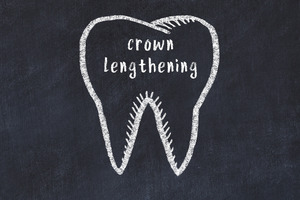
When you go to the dentist for a broken or decayed tooth, you might expect them to start the process of repairing it with a crown right away. However, there are times when certain procedures will have to be performed first – and crown lengthening is a particularly common possibility. Read on to learn more about what crown lengthening is and why it might be necessary.
What is Crown Lengthening?
Crown lengthening is a treatment that is performed on the gum tissues surrounding the base of a specific tooth. The goal is to expose more of the tooth so that a crown (or another type of restoration) can be placed. To do so, a bit of gum tissue is removed, leaving more of the tooth visible above the gumline. Crown lengthening is not a difficult procedure; in fact, dentists can typically complete it in under an hour.
When speaking about crown lengthening, your dentist may also mention gum recontouring. The two procedures are so similar that the terms are often used interchangeably. However, crown lengthening is more likely to be brought up in relation to crown placement.
Why Might You Need Crown Lengthening?
If you’re planning on having a dental crown placed, there are a number of reasons why crown lengthening might be needed first:
- The tooth is severely decayed, and the remaining visible structure isn’t enough to support a dental crown.
- The tooth has broken off at or below the gumline.
- The tooth appears shorter than normal. (Oftentimes, this is a sign of an excessive amount of gum tissue.)
Crown lengthening can also be performed for cosmetic reasons, such as to improve a gummy smile (meaning too much gum tissue can be seen when you pull back your lips). Your dentist can help determine whether the procedure is the best choice for you.
What Will Recovery After Crown Lengthening Be Like?
Since crown lengthening is a very minor type of oral surgery, it will usually only take about two or three days for your mouth to heal afterward. During recovery, you will need to:
- Stay away from any form of strenuous physical activity.
- Eat only soft foods (so long as they aren’t too hot or too cold).
- Keep your swelling down with an ice pack.
- Take ibuprofen if you need to reduce your discomfort.
- Chew on the side of your mouth that’s opposite from where the treated tooth is located.
After about one or two weeks, your dentist may ask you to come in for a follow-up appointment so that they can confirm that your recovery was successful and that it’s okay to move forward with the process of designing and placing a dental crown.
A crown lengthening may sometimes be a necessary step for placing a restoration to protect a tooth. There’s no need to worry if you’re told that you need this procedure; your dentist will make sure that the process is as straightforward and comfortable as possible.
About the Author
Dr. Eric L. Tolliver is a native of Springfield who loves being able to take care of his neighbors’ smiles. He is a past president of the Greater Springfield Dental Society and a past delegate of the Missouri Dental Association. He may recommend crown lengthening for anyone that needs a crown placed. To schedule a consultation with Dr. Tolliver at Galleria Dental of Springfield, visit his website or call (417) 887-5757.
